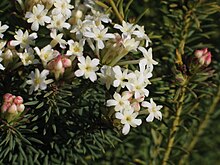Gnidia
| Gnidia | |
|---|---|

| |
| Gnidia tomentosa | |
| Scientific classification | |
| Kingdom: | Plantae |
| Clade: | Tracheophytes |
| Clade: | Angiosperms |
| Clade: | Eudicots |
| Clade: | Rosids |
| Order: | Malvales |
| Family: | Thymelaeaceae |
| Subfamily: | Thymelaeoideae |
| Genus: | Gnidia L. (1753) |
| Species[1] | |
|
104, see text | |
| Synonyms[1] | |
| |
Gnidia is a genus of flowering plants in the family Thymelaeaceae. It is distributed in tropical and southern Africa and Madagascar;[1] more than half of all the species are endemic to South Africa.[2] Gnidia was named for Knidos, an Ancient Greek city located in modern-day Turkey.[3]
These are perennial herbs and shrubs, sometimes with rhizomes. Most species have alternately arranged leaves, and a few have opposite leaves. The leaves are undivided and unlobed. The inflorescence is a head of a few to many flowers. The calyx is cylindrical and the colored lobes may alternate with the petals; some species lack petals.[3] Many species are similar in appearance and difficult to tell apart.[4]
Molecular analyses have provided evidence that the genus is polyphyletic, made up of four different lineages. They are related to the four genera Struthiola, Drapetes, Lasiosiphon, and Pimelea.[5]
Formerly 140 to 160 species were classified in the genus.[2][3][6] Many have been reassigned to other genera and Plants of the World Online currently accepts 104 species.[1]
Species
[edit]

104 species are accepted.[1]
- Gnidia aberrans C.H.Wright
- Gnidia anomala Meisn.
- Gnidia apiculata (Oliv.) Gilg
- Gnidia bambutana Gilg & Ledermann ex Engl.
- Gnidia baumiana Gilg
- Gnidia baurii C.H.Wright
- Gnidia burmanni Eckl. & Zeyh. ex Meisn.
- Gnidia caniflora Meisn.
- Gnidia cayleyi C.H.Wright
- Gnidia chapmanii B.Peterson
- Gnidia chrysantha (Solms ex Schweinf.) Gilg
- Gnidia chrysophylla Meisn.
- Gnidia clavata Schinz
- Gnidia compacta (C.H.Wright) J.H.Ross
- Gnidia coriacea Meisn.
- Gnidia cyanea Burch.
- Gnidia decurrens Meisn.
- Gnidia dekindtiana Gilg
- Gnidia dumicola S.Moore
- Gnidia elkerensis Friis & Sebsebe
- Gnidia ericoides C.H.Wright
- Gnidia fastigiata Rendle
- Gnidia flanaganii C.H.Wright
- Gnidia foliosa (H.Pearson) Engl.
- Gnidia francisci Bolus
- Gnidia fraterna (N.E.Br.) E.Phillips
- Gnidia fruticulosa Gilg
- Gnidia fulgens Welw.
- Gnidia galpinii C.H.Wright
- Gnidia geminiflora E.Mey. ex Meisn.
- Gnidia goetzeana Gilg
- Gnidia gossweileri (S.Moore) B.Peterson
- Gnidia gymnostachya (Meisn.) Gilg
- Gnidia harveyana Meisn.
- Gnidia hirsuta (L.) Thulin
- Gnidia hockii De Wild.
- Gnidia humilis Meisn.
- Gnidia imbricata L.f.
- Gnidia inconspicua Meisn.
- Gnidia insignis Compton
- Gnidia involucrata Steud. ex A.Rich.
- Gnidia juniperifolia Lam.
- Gnidia kasaiensis S.Moore
- Gnidia kundelungensis S.Moore
- Gnidia laxa (L.f.) Gilg
- Gnidia leipoldtii C.H.Wright
- Gnidia linearifolia (Wikstr.) B.Peterson
- Gnidia linoides Wikstr.
- Gnidia meyeri Meisn.
- Gnidia mollis C.H.Wright
- Gnidia multiflora Bartl. ex Meisn.
- Gnidia myrtifolia C.H.Wright
- Gnidia nana (L.f.) Wikstr.
- Gnidia neglecta Z.S.Rogers
- Gnidia newtonii Gilg
- Gnidia nitida Bolus ex C.H.Wright
- Gnidia nodiflora Meisn.
- Gnidia obtusissima Meisn.
- Gnidia oliveriana Engl. & Gilg
- Gnidia oppositifolia L.
- Gnidia orbiculata C.H.Wright
- Gnidia ornata (Meisn.) Gilg
- Gnidia pallida Meisn.
- Gnidia parviflora Meisn.
- Gnidia parvula Dod
- Gnidia penicillata Licht. ex Meisn.
- Gnidia phaeotricha Gilg
- Gnidia pinifolia L.
- Gnidia pleurocephala Gilg
- Gnidia poggei Gilg
- Gnidia polystachya P.J.Bergius
- Gnidia propinqua (Hilliard) B.Peterson
- Gnidia quadrifaria C.H.Wright
- Gnidia quarrei A.Robyns
- Gnidia racemosa Thunb.
- Gnidia rendlei Hiern
- Gnidia renniana Hilliard & B.L.Burtt
- Gnidia robynsiana Lisowski
- Gnidia rubrocincta Gilg
- Gnidia scabra Thunb.
- Gnidia scabrida Meisn.
- Gnidia sericea L.
- Gnidia setosa Wikstr.
- Gnidia simplex L.
- Gnidia singularis Hilliard
- Gnidia sonderiana Meisn.
- Gnidia sparsiflora Bartl. ex Meisn.
- Gnidia spicata (L.f.) Gilg
- Gnidia squarrosa (L.) Druce
- Gnidia stellatifolia Gand.
- Gnidia stenophylla Gilg
- Gnidia strigillosa Meisn.
- Gnidia styphelioides Meisn.
- Gnidia subulata Lam.
- Gnidia tenella Meisn.
- Gnidia thesioides Meisn.
- Gnidia tomentosa L.
- Gnidia usafuae Gilg
- Gnidia variabilis (C.H.Wright) Engl.
- Gnidia variegata Gand.
- Gnidia virescens Wikstr.
- Gnidia welwitschii Hiern
- Gnidia wickstroemiana Meisn.
- Gnidia woodii C.H.Wright
Formerly placed here
[edit]- Lasiosiphon socotranus Balf.f. (as Gnidia socotrana (Balf.f.) Gilg)
References
[edit]- ^ a b c d e "Gnidia L." Plants of the World Online. Royal Botanic Gardens, Kew. Retrieved 15 September 2024.
- ^ a b Rogers, Z. S. (2006). A new species of Malagasy Gnidia and the lectotypification of Octolepis decalepis (Thymelaeaceae). Adansonia, sér. 3(28), 155-60.
- ^ a b c Hyde, M. A., et al. Gnidia. Flora of Zimbabwe. 2013.
- ^ Beaumont, A. J., et al. (2001). Patterns of diversity among involucral bracts, inflorescences and flowers in Gnidia (Thymelaeaceae). Systematics and Geography of Plants 71(2), 419-31.
- ^ Beaumont, A. J., et al. (2009). Gnidia (Thymelaeaceae) is not monophyletic: taxonomic implications for Thymelaeoideae and a partial new generic taxonomy for Gnidia. Botanical Journal of the Linnean Society 160(4), 402-17. doi:10.1111/j.1095-8339.2009.00988.x
- ^ Bhandurge, P., et al. (2013). The Gnidia genus: A review. Asian Journal of Biomedical and Pharmaceutical Sciences 3(19), 1-31.
External links
[edit]- Species listing: Gnidia. Red List of South African Plants. South African National Biodiversity Institute (SANBI).
